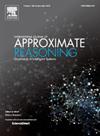Predicting graphical models based on functional data
IF 3
3区 计算机科学
Q2 COMPUTER SCIENCE, ARTIFICIAL INTELLIGENCE
引用次数: 0
Abstract
Graphical models are widely used to model complex relationships between variables in various fields. However, existing analysis methods focus primarily on scalar data and give little attention to addressing the challenges posed by nonscalar data, e.g., functional data, which are prevalent in many real-world applications. Additionally, most methods assume a static graphical model within the observed period, neglecting the dynamic changes that may occur over time. In this paper, we propose a novel method for predicting graphical models based on functional data. Our approach transforms functional data into finite-dimensional vectors via basis function expansion and cross-validation. We then establish a sequential prediction model for determining the correlation coefficient matrix of the decomposed data, thus accounting for the constraints imposed on the matrix via a transformation technique. Finally, we employ conditional independence tests to identify the edges of the predicted graphical model. We demonstrate the effectiveness of our method through extensive simulations and real data analyses. The results show that our method performs better than the competing methods in terms of prediction accuracy and provides valuable insights into the dynamic changes exhibited by a network. This work opens new possibilities for conducting graphical model analyses in various domains, particularly in terms of handling functional data and predicting dynamic relationships.
基于功能数据的预测图形模型
图形模型被广泛应用于各个领域中对变量之间的复杂关系进行建模。然而,现有的分析方法主要集中在标量数据上,很少注意解决非标量数据带来的挑战,例如,在许多实际应用中普遍存在的功能数据。此外,大多数方法假设在观测期内的静态图形模型,忽略了可能随时间发生的动态变化。本文提出了一种基于功能数据的图形模型预测新方法。我们的方法通过基函数展开和交叉验证将函数数据转换为有限维向量。然后,我们建立了一个序列预测模型,用于确定分解数据的相关系数矩阵,从而通过变换技术考虑对矩阵的约束。最后,我们使用条件独立检验来识别预测图形模型的边缘。我们通过大量的模拟和实际数据分析证明了我们方法的有效性。结果表明,我们的方法在预测精度方面优于竞争对手的方法,并对网络所表现出的动态变化提供了有价值的见解。这项工作为在各个领域进行图形模型分析开辟了新的可能性,特别是在处理功能数据和预测动态关系方面。
本文章由计算机程序翻译,如有差异,请以英文原文为准。
求助全文
约1分钟内获得全文
求助全文
来源期刊

International Journal of Approximate Reasoning
工程技术-计算机:人工智能
CiteScore
6.90
自引率
12.80%
发文量
170
审稿时长
67 days
期刊介绍:
The International Journal of Approximate Reasoning is intended to serve as a forum for the treatment of imprecision and uncertainty in Artificial and Computational Intelligence, covering both the foundations of uncertainty theories, and the design of intelligent systems for scientific and engineering applications. It publishes high-quality research papers describing theoretical developments or innovative applications, as well as review articles on topics of general interest.
Relevant topics include, but are not limited to, probabilistic reasoning and Bayesian networks, imprecise probabilities, random sets, belief functions (Dempster-Shafer theory), possibility theory, fuzzy sets, rough sets, decision theory, non-additive measures and integrals, qualitative reasoning about uncertainty, comparative probability orderings, game-theoretic probability, default reasoning, nonstandard logics, argumentation systems, inconsistency tolerant reasoning, elicitation techniques, philosophical foundations and psychological models of uncertain reasoning.
Domains of application for uncertain reasoning systems include risk analysis and assessment, information retrieval and database design, information fusion, machine learning, data and web mining, computer vision, image and signal processing, intelligent data analysis, statistics, multi-agent systems, etc.
 求助内容:
求助内容: 应助结果提醒方式:
应助结果提醒方式:


